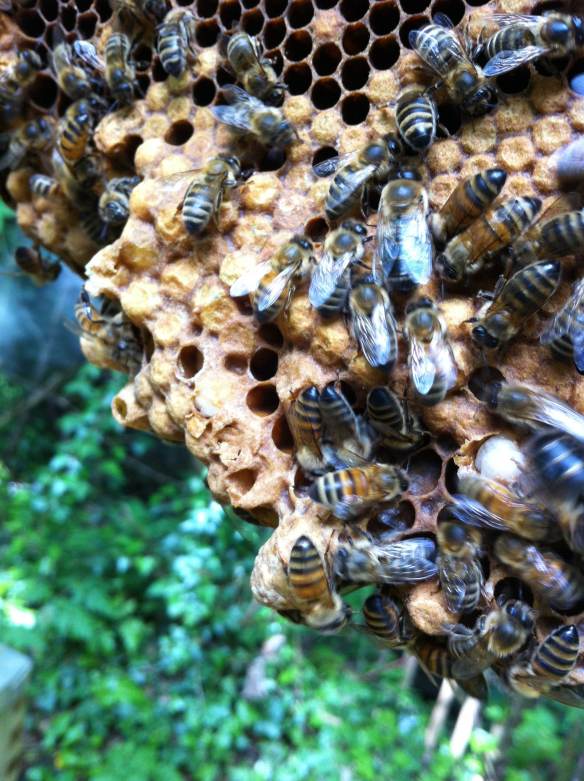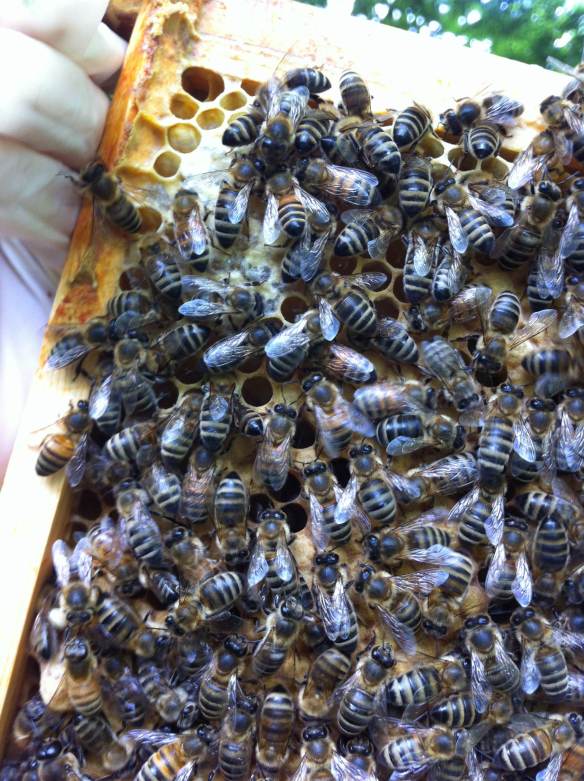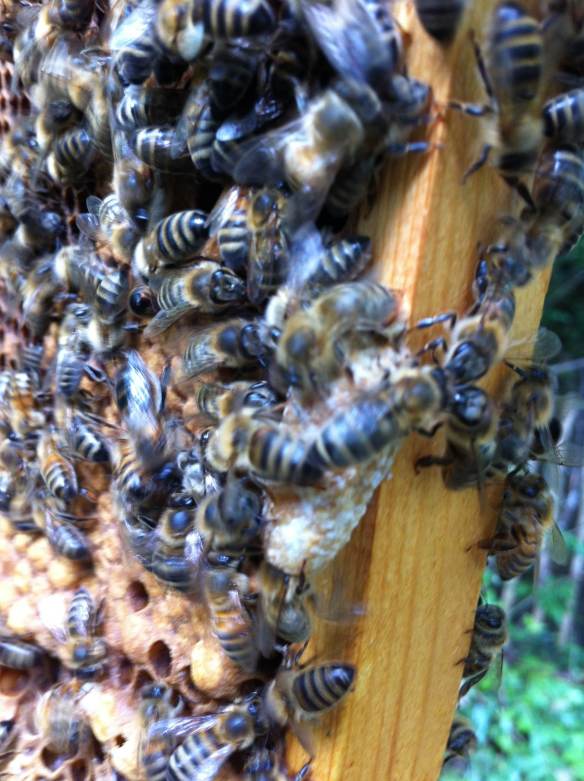Our bees are feeling swarmy.
Last Saturday afternoon Emily and I found three queen cells in the hive we bought from Charles recently. And in a surprising display of competent beekeeping, we demonstrated how to do an artificial swarm to an audience of three beginner beekeepers.
We found the queen and put her in a nuc (baby hive box) with four frames of brood and stores (honey and pollen), a frame of foundation (so the small colony can grow) and I had the (unenviable) task of shaking in two frames of flying bees. We then ‘took down’ (polite beekeeping term for ‘destroyed’) one queen cell in the original hive and left two queen cells inside.
As usual, beekeepers have different ideas about how many queen cells to leave inside a hive: too few might risk the colony becoming queenless if the new queen(s) fail, and too many might risk the colony trying to swarm again. But it seemed for now we had stopped the bees from swarming and had (potentially) a third hive.
Emily and Drew returned to the apiary on Sunday to move the nuc to the location of the original hive so that the foraging bees would return to the nuc and boost its numbers.
So far so good.
Today we returned to see how our swarmy bees were getting on.
And discovered they are still feeling swarmy.
Five new queen cells!
We decided not to destroy the new queen cells and ask if another beekeeper at our apiary needed queens.
We then inspected the nuc and found that the small colony will soon need to be moved into a grown-up hive. And we named the queen Rose, because she seems rather nice.
Luckily nothing as exciting was happening in Myrtle’s hive. Our well-behaved bees are doing the Bailey comb change exactly as the books say. We found and put Myrtle in the top brood box to encourage the colony to move upstairs into their new home.
Later that day Emily returned to the apiary and sent a text to say the elder beekeepers had advised making another nuc from the extra queen cells. So we now have four colonies at Perivale apiary and one at Hanwell which is also bursting at the seams. This could all get out of hand.





So many bees! Great photos of the qcs. Hoping the bees might take a rest from making any more for a while now, couldn’t cope with our other hives turning into three too!
Last year too few bees and this year too many – never a dull moment!
Ditto – great photos of QCs!
Thanks – taken with iPhone and gloved hands 🙂
lovely post as always
Thank you Linda! It has been a fun spring so far!
I have just finished a demaree on my 5 strongest hives. Found only 2 charged QC’s so may have just timed it right. How many frames of brood were in the colony that is producing so many QC’s ?
There was brood on almost every frame so they built up very rapidly and seems a textbook ‘run out of space and swarm’! Even though we’d started a bailey swarming seemed their preferred option. Your bees sound like they’re doing great 🙂
So far so good for my hives but with bees you never know! I think the more bees / years you keep them the more you start to understand them (a little). Were your bees swarmy last year? I started my demaree manipulations earlier (in terms of colony development) this year after last years experience!
I think you’re right! Our bees were swarmy last year despite the rain (https://missapismellifera.com/2012/06/02/the-bad-beekeepers-club/).
The bee examiner at my basic assessment said it might have been due to rain keeping more bees inside the hive for longer periods leading to queen substance becoming too dilute and making colony feel less ‘cohesive’ and more likely to swarm.
She’d seen many swarms from colonies who still had plenty of brood space during the prolonged spell of rain. Who knows? I’d have to read up more or do beekeeping a few more years…
The demaree sounds like an interesting way to prevent swarms, maybe Emily and I will try it one year.
The weather definitely has an influence on swarming and last year was a spectacular year for swarming!
Having checked the 5 colonies that I demareed last week only one had charged QC’s and that was the polyhive that had a couple of early stage QC’s when I demareed it! So I removed them and made a Nuc from the top box with a nice QC. I will inspect that colony again soon to see if they are intent on swarming.
The guy that taught me the method said that the demaree will only delay the swarm process and that most of the time you will have to split the colony at some point but in the meantime you build a massive colony up and get a good honey crop!
I’ve heard that some hives just want to swarm and now amount of splitting or queen cell destruction will stop them. Oh the fun of keeping wild animals with strong wills! I hope it all works out and you have some good hives to grow and collect through spring and summer.
Our new ladies are wilful! I’ve heard that too and swarming is a natural instinct of bees. If I lived in the country with acres of woodland I think I’d let them swarm as I don’t mind about the honey, but it’s not practical or sociable to do that in the city.
Exactly. I lived in terror of a neighbour phoning to tell me a swarm had just landed on their balcony. Luckily that never happened, but it is a worry.
Neighbours are more terrifying than bees! 😉
Your bees are doing very well considering it hasn’t been a good spring.
They made the most of the few days of sun that’s for sure! Our bees deserve a better season this year.
Pingback: Our queens come in eights | Adventuresinbeeland's Blog
All very exciting…
I know the feeling, when you have to ‘take down’ some queen cells and don’t know whether you are leaving the best or the worst and what will become of therm….
I split my colony around 10 days ago and knocked off 4-5 extra queen cells on Thursday.
Neither colony is big enough to split again for a third, so fingers crossed for the original and the new one!
Sara x
It always seems a waste to destroy queen cells as someone usually needs a queen, and I don’t like to second guess nature.
Your bees are doing brilliantly – you’ll be staring your own apiary! x
I am envious! My bees died over the winter. I ordered 2 packages of bees this spring and have yet to see them. Evidently Georgia is having wet and cold weather like we have had this spring and can’t ship the orders. I am beeless!
Oh no! I’m so sorry to hear about your bees – I lost my first hive over winter and it was a hard blow. Fingers crossed you get some sun and bees soon!
I’m glad you were able to give your queen cells away without having to destroy them. I always squirm a little when the more experienced bee keepers tell me to cull the queen cells. Being a little rebellious, I never do…but then I have to catch the swarms (if I can.)
I know what you mean when you say “This could get out of hand…” Between my two original hives, I had SEVEN swarms. I caught four. It was a wild month!!
Seven swarms – amazing and that you caught four!
I agree – better to give away or nuc the queen cells than destroy them. We are supposed to be helping bees!
I love that first photo, well done!
Cheers! Taken rather shakily with an iPhone and Emily holding up the frame.
hahaha. Some years you struggle to keep your colony alive and others you can’t keep them seem to keep them all straight. I hope none of them swarm, even though it is rather a fun thing to see!
Bees don’t like you to feel comfortable…
They certainly don’t!
I’m completely clueless about beekeeping, since I’ve never participated. But I like following this blog because it fascinates me and I like bees (and I like what they make even better!). I always thought it might be fun to do beekeeping, but my husband is allergic, and I get the sense it might be a bit of an expensive thing to do.
I’m wondering–I know that I’ve read that there is a sort of bee crisis, with bees disappearing and less bees being around the last few years. Isn’t it a good thing if bees swarm and create new queens? I mean, doesn’t that mean more hives, which is good for pollination of the plants? I know that if the bees swarm and you can’t catch them (how does one catch a swarming hive, I wonder?) that means you lose them and lose out on the honey and other goodness the bees provide, so it’s probably no fun for the beekeeper, but isn’t it good for the planet in general?
These posts always give me stuff to ponder, Emma! Thanks. 🙂
It can be expensive (helpful to share costs with a hive partner and if you can actually harvest honey to sell!) and I’m allergic too so it’s something to consider if you’re taking extra care.
But glad you can enjoy beekeeping vicariously on my blog 🙂 Consider yourself an honorary beekeeper Holly!
That’s an interesting question. Yes, swarming is the way honeybees, as a species, reproduce naturally in the wild. So one colony swarms and the forest has two colonies, then maybe four, then eight… In beekeeping artificial swarm control usually results in one hive becoming two, or three.
In an ideal world there would be enough habitat everywhere for bees to swarm and set up new homes, and people wouldn’t mind sharing their spaces with them. Sadly this isn’t the case in urban areas. However, if a colony does swarm in London there’s usually a beekeeper willing to catch it and home it in a hive.
My association’s website has an info page on swarms: http://ealingbees.wordpress.com/swarms/
And this YouTube video shows beekeepers catching a swarm: http://www.youtube.com/watch?v=GScLrxeTArY
Thanks for your comment Holly! 🙂
“Feeling swarmy…” Nice concept. Any human application? (Is it what happens on a sunny Bank Hol. when 1/2 of southern england climbs into a car and heads for the coast? With undertones of warm and swimmy).
Interesting you should say, I watched a CH4 program this week on the concept of human swarming http://www.channel4.com/info/press/programme-information/human-swarm
Crowds of half naked people swarming to Regent’s Park the moment the sun comes out at lunchtime lead me to think this is true…
Amazing! Well, they must be happy bees, Em! 🙂
Looks like you are gaining an abundance of bees this year 🙂
Pingback: The wheel turns | Miss Apis Mellifera